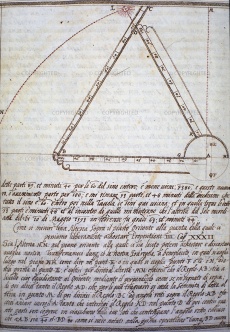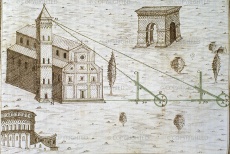Triquetrum
From Inventions
Name used since the Middle Ages (in Latin triquetrum=triangular).
Contents |
Inventor
Claudio Tolomeo
Historic Period
II secolo
Description
Instrument for astronomical and terrestrial measurements, also called "Gran Regola" (Great-Rule) of Ptolemy, attributed to Ptolemy (middle of the 2nd century C.E.). According to the description given by Antonio Santucci (?-1613) in his manuscript Trattato di diversi instrumenti matematici [Treatise on various mathematical instruments] (1593), the instrument is composed of two pivoting rods, like compasses, divided lengthwise into 100 parts and fitted with a protractor at the hinge. A third rod pivots at the end of one of the main rods. Its length is equal to the diagonal of the square constructed from the two main rods, and it is thus divided into 141 and 2/5ths parts. A third rod pivots at the end of one of the main rods. Its length is equal to the diagonal of the square constructed from the two main rods, and it is thus divided into 141 and 2/5ths parts. The instrument was used to measure the height of the Sun on the horizon, the distances between celestial bodies, and terrestrial distances, as well as for surveying. In the latter application, and because of its structure, it may be regarded as the prototype of the archimetro fiorentino.
Bibliographical Resources
Santucci, Antonio, Trattato di diversi Istrumenti Matematici che si conservano al presente nella Guardaroba del Gran Duca di Toschana. Presi in disegno in questo libro, con le loro operazioni. Come in misurare le lunghezze, larghezze, altezze, overo profondità; così delle cose terrene come Celesti; Similmente in levar le piante delle Provincie o di qual si voglia cosa con ogni particolarità che giustamente stien ne' luoghi loro, ms., Firenze, Bibl. Marucelliana, Ms. C 82.
Images
Author of the entry: Filippo Camerota



